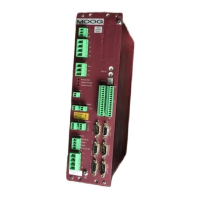SECTION 6: T200 FUNCTIONAL OVERVIEW T200 User's Manual
PAGE 6-15
6.4.2.1 High Power Circuit Description
The high power supply section may be divided into functional blocks:
• High voltage rectification and filtering
• Soft-start of a.c. mains power-on
• Low voltage control power supply
• Regeneration circuit
• Monitoring and fault logic circuits
a) High Voltage Rectification and Filtering
The a.c. mains input is rectified by a three phase diode bridge and filtered by a bank of electrolytic capacitors to generate
a nominal 325 V d.c. supply. This high power 325 V d.c. supply is unregulated and will vary in direct proportion with
the a.c. mains input voltage magnitude.
A.C. Mains Type D.C. Bus Voltage Level
230V Single and Three Phase Mains 325Vd.c.
120Va.c. Mains 170Vd.c.
Table 6.1:- Magnitude of the D.C. Bus
b) Soft Start
Soft start is used to limit the inrush current to the d.c. bus capacitor bank on application of a.c. mains power. This is
intended to prevent nuisance tripping of circuit breakers or blowing of line fuses on power-up.
The soft start relay will close when the monitoring circuit senses that the high-voltage d.c. bus has charged up to close to
the value of the rectified a.c. mains.
Section 3.10 provides details on how the soft-start circuitry functions when T200-X00's are connected to a T200-X10 via
the D.C. Bus.
c) Low Voltage Control Power Supply
Control power for the logic circuits is generated by a DC/DC converter, which provides control-circuitry power that is
isolated from the mains input. This control voltage also powers the cooling fans. The DC/DC can generate control
power from three sources
1. D.C. Bus if it is greater than 250Vd.c.
2. 24Vd.c. external supply which is provided by the user specifically for control-backup power.
3. Isolated 120Va.c. external supply which is provided by the user specifically for control-backup power.
The T200 will always generate power internally from the D.C. Bus (if its voltage is greater than 250Vd.c.) even though
the 24Vd.c. and/or the 120Va.c. control-backup supplies are present.
d) Regeneration Circuit
Rapid motor deceleration or an overhauling load creates a situation in which energy is returned back into the D.C. Bus.
The Regeneration energy will charge up the power supply bus capacitors, causing their voltage to increase. To prevent
capacitor overvoltage, a shunt regulator circuit senses when the bus voltage exceeds the Regeneration cut-in voltage and
switches a Regeneration resistor across the D.C.Bus, (via a Regeneration transistor) to dissipate the Regeneration
Artisan Technology Group - Quality Instrumentation ... Guaranteed | (888) 88-SOURCE | www.artisantg.com

